A high bounce rate can affect your business, because it effectively means low conversion rate. For instance, visitors don’t stay long enough to be converted to subscribers, buyers or members. This means that they click on your content, linger for a few seconds and for one reason or another, don’t stick around to check out any other pages.
Even when bounce rates are poor, it serves as an indicator that something needs to be rectified on your website. Very poor bounce rates are frustrating, but not crippling. A bounce rate of 51% is seen as being average, while 60% is deemed okay. However, a bounce rate of 70% is – by all things analytics – a disappointment. Therefore, this article suggests steps you can take to significantly reduce your website’s bounce rate.
1: Focus on the right kind of audience
Your visitors are attracted to your site because of the keywords you‘ve used to optimise for search engines. However, are you delivering on your promise of actually dealing in the things suggested by your choice keywords? Make sure you’re attracting the desired audience. If you ‘e selling sanding machines for example, use only keywords related to them. Don’t use those of stains, unless you also sell hardwood floor stains. This is a waste of your SEO power, so look at the keywords you’ve been using and make some changes, with the aim of catering to only the right kind of audience.
2: Make your site mobile-friendly
You’ll find that a greater number of people using the internet today (especially for web searches) do so via their mobile phones. Therefore, when building or updating your site, keep in mind this group of people; after all, they make up over 50% of your potential consumers and will leave your site immediately if they’re not able to navigate it comfortably. Every user believes that there are many websites out there ready to serve them better and they won’t hesitate to find them if need be. So, if you haven’t made your site mobile friendly already, this might explain why you have a high bounce rate.
3: Avoid Pop-ups
For what it’s worth, pop-ups aren’t entirely undesirable to your website, as there are advantages – especially in highlighting any specifics you want the visitor to have at the back of their mind. However, regardless of any advantages, it is actually a satisfying overall experience that reduces your bounce rate. Pop-ups can be distraction to the visitor – especially when they’re not deployed appropriately. If ever you do use them, make pop-ups small and reduce the amount of times they are set to show up on the screen.
4: Speed Up Your Website
Speed and content are key. Speed is what is going to make users stay and consume the quality content you’ve published. Consequently, this increases the quality of the user experience. Studies show that websites slow to load have a 72% higher bounce rate than those that load faster. Therefore, high speed sites are bound to rank even higher on search engines, as visitors often relax and browse through most of the landing pages. Sites like Godaddy and www.umbrellar.com, offer some of the best cloud computing services (and much more) – and deliver premium experience for users.
5: Fix HTTPS mixed-content warnings
This is generally experienced with websites designed to run over HTTPS, also serving over HTTP. It’s common with large websites that want to benefit from both, and the situation creates a huge problem on the internet. Of course, migrating from HTTP to HTTPS will help you take advantage of SEO and consequently increase your conversion rate. However, you’ll be getting mixed content signals, like ads running over HTTP WordPress plugin. Therefore, you should check your site across all types of browsers to see it isn’t creating an increase in your bounce rate Should that happen, you’ll need to duly fix it.
6: Use promotions Sidebar Widgets sparingly
Some web pages are littered with ads, emblems, awards, and so on, which can appear as though they’re actively begging visitors to bounce. If you’re adding promotions on your sidebar, do so sparingly. Also, you should get creative with it. Let the sidebar promotions serve an actual purpose and be related to the blog content aside which they’re published.
7: Make use of a clear ‘Call to Action’
You’ve provided visitors with a quality content, which they should find relevant. By now, they should have also looked through it. Therefore, you should consider what you want them to do after this point. When you’ve considered this, be sure to arrive at a clear Call to Action, which you will include in the content. Preferably, it should be just one button, as well as precise and strategically positioned, so that you achieve the desired results.
8: Use landing pages that satisfy the user’s needs
The ability to keep your reader on the page for as long as possible is very important – especially in relation to your site’s bounce rate. Sometimes, the keywords they used or the page that led them to your site isn’t really what they wanted initially. So, have landing pages that are equally important and within the niche they searched for, as this will do the trick of having them stay as long as possible and will significantly minimise your bounce rate.
9: Optimise your content length
Lengthier content ranks higher on Google; therefore, you’re advised to make yours longer than 300 words. However, it should not be too long, as this will discourage your visitors from going ahead and reading them. Some users just want to get the gist of their query, rather than read an epistle. Your content might be what they want, but due to its length, they will end up bookmarking it to read later, which they may never get round to doing. In turn, this will lead to higher bounce rate. So, craft contents that a user can consume in a considerably short time.






Leave A Comment